 26-08-2020
26-08-2020
Insurance regulator Irdai may tighten rules for companies

 Insurance Alertss
Insurance AlertssInsurance regulator Irdai may tighten rules for companies
The insurance regulator is likely to tighten licence norms, favouring candidates that are resilient to deep and prolonged crises, said two people with direct knowledge of its policymaking processes, including a government official.
“Only entities that are financially strong enough, not only at the time of entry but also during tough liquidity phases for 5-10 years, may get a licence to launch or acquire an insurance company," said one of the two people cited above, requesting anonymity.
A wave of financial stress at insurers, especially those run by non-banks and over-leveraged corporates, has stirred concerns about the ability of the promoters to support the business amid tight liquidity conditions, insolvency issues and the slump in business caused by the covid pandemic.

“Capital requirement norms and exposure parameters of promoters may need to be strengthened. Stronger promoter financials should be the new licence criteria," the second person said, adding that the Insurance Regulatory and Development Authority of India (Irdai) is examining the issue.
Insurance is a capital-guzzling business, requiring a constant infusion of capital by promoters in the initial years. This is because the cost requirements of basic office operations, creating sales reach, settling claims and building volumes take several years. The financials of non-bank lenders have weakened since 2018 following the crisis at Infrastructure Leasing and Financial Services Ltd, which, in turn, has made it tough for them to support their insurance units. To make matters worse, there has been a slump in premium incomes because of the lockdown.
“Irdai may review and tighten the norms relating to minimum paid-up equity capital, reserves, sum at risk, solvency, and so on. If the debt position of the promoter is too high, Irdai may not grant insurance licence to such an entity," said the first person.
Insurers are required to have a minimum paid-up capital of ₹100 crore. Irdai feels this amount needs to be raised so that the insurer has enough capital to carry on business for at least five years, without requiring additional capital infusion.
For every insurer, initial capital is important to bear the losses, expenses and claims during the first five years, and if any of the joint venture partners are unable to bring in capital, the solvency margin of the insurer may be impaired. It is mandatory to maintain a solvency margin of 150% for every insurer.
Since promoters of many insurers are not in a position to infuse capital because of the tight financial situation at the parent level, the regulatory requirement of paid-up capital under the new norms may be increased. This will not only ensure enough capital at hand for the insurer but also keep the solvency margin healthy to remain afloat. Solvency margin is the extent to which an insurance company’s assets exceed its liabilities.
Irdai is also evaluating increasing the solvency margin threshold from 150%. This is crucial because the solvency ratio of many life and general insurers has been deteriorating and are close to the regulatory minimum of 1.5. In order to maintain a healthy solvency margin, either the promoters need to infuse capital, or they need to earn profit through sales of a large number of policies for many years or minimize expenses and liabilities drastically.
Irdai may also revise the norms on reserves that insurers need to maintain. Reserve is basically the cash position that will eventually grow to cover say the death benefit in its entirety by a certain age. Irdai feels reserve requirements may need to be relooked as the premium collection from policy sales is decreasing rapidly, which may increase the risk for the insurer because in case of large-scale claims, the insurer may not have enough money in the reserve to honour it. Claims reserve is built with the money from policy premium. Irdai, while revising the norms, also wants to ensure that for every insurer, the sum at risk is not too high as a proportion of the reserve. This is critical as mortality costs rise each year. The difference between the reserve and the death benefit is the sum at risk to the insurer.
An email sent to Irda chairman did not elicit any response.
Source: Live Mint
